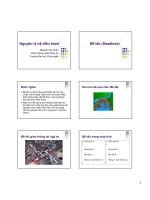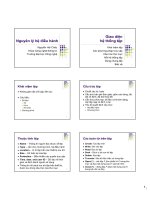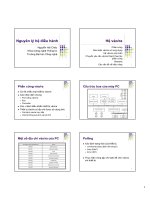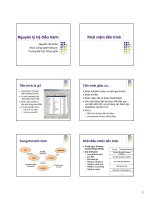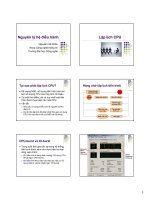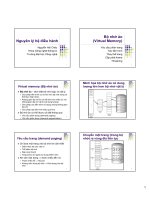Nguyên lý hệ điều hành (mục File system interface)
Bạn đang xem bản rút gọn của tài liệu. Xem và tải ngay bản đầy đủ của tài liệu tại đây (1.3 MB, 51 trang )
Chapter 11
File-System
Interface
Nhóm 11
Nhóm 11
Nhóm em gồm 3 thành viên :
-Dương Minh Hải
-Nguyễn Hồng Phúc
-Cao Văn Hiếu
Chaper 11
01
File Concept
04
File-System
Mounting
02
Access Methods
05
File Sharing
06
Protection
03
Disk and
Directory
Structure
Objectives
● To explain the function of file systems
● To describe the interfaces to file systems
● To discuss file-system design tradeoffs, including
access methods, file sharing, file locking, and
directory structures
● To explore file-system protection
1.File Concept
File Concept
● File Attributes
● File Operations
● File Types
● File Structure
● Internal File Structure
File Attributes
●
●
●
●
●
●
●
Name – only information kept in human-readable form
Identifier – unique tag (number) identifies file within file system
Type – needed for systems that support different types
Location – pointer to file location on device
Size – current file size
Protection – controls who can do reading, writing, executing
Time, date, and user identification – data for protection, security, and usage
monitoring:
● Information about files are kept in the directory structure, which is maintained on the
disk
● Many variations, including extended file attributes such as file checksum
● Information kept in the directory structure
File Operations
● The file ADT supports many common operations:
○ Creating a file
○ Writing a file
○ Reading a file
○ Repositioning within a file
○ Deleting a file
○ Truncating a file.
File Operations
● Most OSes require that files be opened before access and closed after all access is
complete. Normally the programmer must open and close files explicitly, but some
rare systems open the file automatically at first access. Information about currently
open files is stored in an open file table, containing for example:
○ File pointer - records the current position in the file, for the next read or write
access.
○ File-open count - How many times has the current file been opened
( simultaneously by different processes ) and not yet closed? When this counter
reaches zero the file can be removed from the table.
○ Disk location of the file.
○ Access rights
File Operations
● Some systems provide support for file locking.
○ A shared lock is for reading only.
○ A exclusive lock is for writing as well as reading.
○ An advisory lock is informational only, and not enforced. ( A "Keep Out" sign,
which may be ignored. )
○ A mandatory lock is enforced. ( A truly locked door. )
○ UNIX used advisory locks, and Windows uses mandatory locks.
File Types
● Windows ( and some other systems ) use special file extensions to indicate
the type of each file:
● Macintosh stores a creator attribute for each file, according to the program
that first created it with the create( ) system call.
● UNIX stores magic numbers at the beginning of certain files. ( Experiment
with the "file" command, especially in directories such as /bin and /dev )
File Structure
● Some files contain an internal structure, which may or may not be known to the OS.
● For the OS to support particular file formats increases the size and complexity of the
OS.
● UNIX treats all files as sequences of bytes, with no further consideration of the internal
structure. ( With the exception of executable binary programs, which it must know how
to load and find the first executable statement, etc. )
● Macintosh files have two forks - a resource fork, and a data fork. The resource fork
contains information relating to the UI, such as icons and button images, and can be
modified independently of the data fork, which contains the code or data as
appropriate
Internal File Structure
● Disk files are accessed in units of physical blocks, typically 512 bytes or some power-oftwo multiple thereof. ( Larger physical disks use larger block sizes, to keep the range of
block numbers within the range of a 32-bit integer. )
● Internally files are organized in units of logical units, which may be as small as a single
byte, or may be a larger size corresponding to some data record or structure size.
● The number of logical units which fit into one physical block determines its packing,
and has an impact on the amount of internal fragmentation ( wasted space ) that
occurs.
● As a general rule, half a physical block is wasted for each file, and the larger the block
sizes the more space is lost to internal fragmentation
2.Access
Methods
Access Methods
● Sequential Access
● Direct Access
● Other Access Methods
Sequential Access
● A sequential access file emulates magnetic tape operation, and generally supports a
few operations:
○ read next - read a record and advance the tape to the next position.
○ write next - write a record and advance the tape to the next position.
○ rewind
○ skip n records - May or may not be supported. N may be limited to positive
numbers, or may be limited to +/- 1.
Direct Access
● Jump to any record and read that record. Operations supported include:
○ read n - read record number n. ( Note an argument is now required. )
○ write n - write record number n. ( Note an argument is now required. )
○ jump to record n - could be 0 or the end of file.
○ Query current record - used to return back to this record later.
○ Sequential access can be easily emulated using direct access. The inverse is
complicated and inefficient.
Other Access Methods
● An indexed access scheme can be easily built on top of a direct
access system. Very large files may require a multi-tiered indexing
scheme, i.e. indexes of indexes.
3.Disk
-Directory
Structure
Disk - Directory Structure
● Storage Structure
● Directory Overview
● Single-Level Directory
● Two-Level Directory
● Tree-Structured Directories
● Acyclic-Graph Directories
● General Graph Directory
Storage Structure
● A disk can be used in its entirety for a file system.
● Alternatively a physical disk can be broken up into multiple partitions, slices,
or mini-disks, each of which becomes a virtual disk and can have its own
filesystem. ( or be used for raw storage, swap space, etc. )
● Or, multiple physical disks can be combined into one volume, i.e. a larger
virtual disk, with its own filesystem spanning the physical disks.
Directory Overview
● Directory operations to be supported include:
○ Search for a file
○ Create a file - add to the directory
○ Delete a file - erase from the directory
○ List a directory - possibly ordered in different ways.
○ Rename a file - may change sorting order
○ Traverse the file system.
Single-Level Directory
● Simple to implement, but each file must have a unique name
Two-Level Directory
● Each user gets their own directory space.
● File names only need to be unique within a given user's directory.
● A master file directory is used to keep track of each users directory, and must be
maintained when users are added to or removed from the system.
● A separate directory is generally needed for system ( executable ) files.
● Systems may or may not allow users to access other directories besides their own
○ If access to other directories is allowed, then provision must be made to specify
the directory being accessed.
○ If access is denied, then special consideration must be made for users to run
programs located in system directories. A search path is the list of directories in
which to search for executable programs, and can be set uniquely for each user.
Tree-Structured Directories
● An obvious extension to the two-tiered directory structure, and the one with which we
are all most familiar.
● Each user / process has the concept of a current directory from which all ( relative )
searches take place.
● Files may be accessed using either absolute pathnames ( relative to the root of the
tree ) or relative pathnames ( relative to the current directory. )
● Directories are stored the same as any other file in the system, except there is a bit that
identifies them as directories, and they have some special structure that the OS
understands.
● One question for consideration is whether or not to allow the removal of directories
that are not empty - Windows requires that directories be emptied first, and UNIX
provides an option for deleting entire sub-trees.


